|
|
Sundridge

|
|
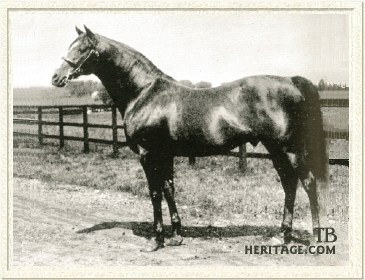 |
|
|
Sundridge's name is synomous with brilliance, and his is the kind of professional sprinting speed that appealed on both sides of the Atlantic in the early 1900s. Through his many useful sons and one particularly influential daughter, Sundridge's name is shot through the pedigrees of European and American pedigrees, which has enabled his descendants to travel back and forth internationally with great success.
At the turn of the century in England, the male line of Vedette, through Galopin and St. Simon, was dominating as a source of classic winners and great stayers. But Vedette himself had not been a prolific sire. Besides Galopin, his only other offspring of note was Speculum, a top class runner and Leading Sire in 1878 when Sefton won the Derby. Sefton was a failure at stud, and another son, Hagioscope, sired Queen's Birthday, who got Santoi, but it was Speculum's son Rosebery was the one who carried this branch of the line forward in a significant way.
As a four-year-old, Rosebery pulled off an amazing pair of victories when he won the Cesarewitch Handicap (two and a quarter miles) and then the Cambridgeshire Handicap (about a mile and an eighth) late in the 1876 season. Unfortunately, Rosebery was not an overwhelming success at stud. Besides Knight of the Thistle, his only other major runner was the outstanding Amphion.
Amphion's sire is officially listed as "by Speculum or Rosebery" because when his dam, Suicide, was bred in 1885, initially to Speculum, the stallion died shortly after the cover. The mare came back in heat, and the dilemma was solved by breeding Suicide to the next best thing, Speculum's son Rosebery, standing just a mile down the road. As Joe Palmer described it in Names in Pedigrees, "Speculum's line was perpetuated, oddly enough, by his death."
Although possessed of a phlegmatic temperament, the chestnut Amphion proved himself one of the best in training every year he raced. He won fourteen of twenty-four starts in four seasons; his best year was as a four-year-old, when his victories included the Hardwicke Stakes at twelve furlongs, beating Derby winner Sainfoin and 2,000 Guineas winner Surefoot; the seven furlongs Lancashire Plate, beating Martagon, Memoir (Oaks and St. Leger), and St. Serf; and the ten furlongs Champion Stakes, beating Memoir at weight-for-age.
Amphion retired to Compton Stud in Dorset (now Sandley Stud) and died there in 1906. A good but not great sire, he tended to get more precocious speed than any stamina he had displayed on the racecourse. His best runner by far was the subject of this essay, Sundridge, typical of his sire's offspring in being a sprinter. Amphion also sired *Dieudonne (Middle Park S., Champion S., Sussex S.), Lally (Champagne S., Richmond S., Newmarket S., Royal Hunt Cup, Eclipse S.), Amphora (Gimcrack S.), Bettyfield, Acclaim, Altesse, Elmstead, and Horoscope (in U.S.). His daughters included the dams of Hapsburg, Perrier, Dark Legend, Harmonicon, and Celt.
Sundridge's dam was Sierra (1889 by Springfield ‚ Sanda by Wenlock), a full sister to Derby winner Sainfoin, who Amphion had bested in the Hardwicke Stakes. The breeder was Queen Victoria, whose Hampton Court Paddocks had produced a number of good ones, despite the monarch's distaste for the sport. Unraced, Sierra was unsound in her wind (Ulbrich says she had "a latent defect in one of her nostrils"). In 1893, she produced the good filly Amphora (by Amphion), and in 1894 was bought by Sir Samuel Scott, for whom she produced a chestnut colt by Amphion in 1898, later named Sundridge. Her last foal was born in 1895, another colt by Amphion. The mare died shortly after the birth; the colt became the good stakes winner Elmstead.
Sundridge on the Turf
Racing for his breeder, Sir Samuel Scott, Sundridge was training as a two-year-old when he fractured his hip, an odd family tradition, since Sierra's sire Springfield had suffered a similar, although less severe injury as a juvenile. Sundridge spent three months in a sling recovering and so could not debut until late in the season, in fact on October 24, when he ran unplaced in a maiden event at Newmarket won by St. Solon.
Sundridge raced nine times at three and won four times. Since he was never a classic contender, his three-year-old season was workmanlike, racing against older horses from the start, and mostly just sprinting. He started the season off with a win in the five furlongs Heath Highweight Handicap on May 1 at Newmarket. The race name is deceiving, since the colt carried only 104 pounds to beat four-year-old Star of Hanover, carrying 121 pounds, by a length. A little over a week later, on May 9, the tables were turned, as Sundridge was assigned 127 pounds in the six furlongs Earl of Chester's Welter Handicap, and defeated Silverhampton (114 pounds) by three lengths, with Cassine (132 pounds) in third.
Beaten by five-year-old Master Willie in the Royal Stakes at Epsom with *Dieudonne third, Sundridge won the July Handicap (six furlong) carrying just 104 pounds, with Rose Tree (117 pounds) in second. In the Portland Plate at five furlongs-plus at Doncaster, Sundridge (110 pounds) lost by three-quarters of a length to *Dieudonne (112 pounds).
Having sprinted only up to this point, in late September, Sundridge went for the Prince Edward Handicap over ten furlongs, but failed under 106 pounds and ran unplaced, with Fancy Man the winner. The effort paid a toll, and he ran unplaced in the Richmond Plate and again in the Croxteth Plate before returning with a victory in the Chatsworth Plate over five furlongs at Derby in mid-November.
At four, Sundridge began to keep more consistently good company, but was limited to sprinting, a job at which he was most proficient. In nine starts, he won three times, starting with the Teddington Plate over six furlongs at Kempton, which he won easily by two lengths carrying 121 pounds, beating Verus (107 pounds) and Phylloxera (95 pounds). In the Royal Stakes, six furlongs at Epsom, he was unplaced, but bounced back to win his first of three consecutive July Cups (six furlongs, Newmarket).
Unplaced in the Stewards' Cup at Goodwood under 130 pounds, he was third in the Marine Plate at Brighton, unplaced in the Richmond Plate, then a close second in the Challenge Stakes to American-bred Chacornac, giving that colt three pounds. Second again in the Stewards' Plate at Liverpool, Sundridge finally returned a winner in the Chatsworth Plate for the second year in a row, in his final start of the season.
At the end of his four-year-old year, Sir Samuel ran Sundridge through the Newmarket December Sales. He felt the horse to have "gone in the wind," apparently a belief shared by others in the crowd, since James B. "Jack" Joel was able to purchase the proven sprinter for only £1,450. Joel's trainer, Morton, passed the colt physically and went on to campaign him to even greater success.
Sundridge's five-year-old campaign consisted of seven starts, five wins, and he was sprinting at the top of his game. He won the six furlongs Teddington Plate carrying 123 pounds; won the Royal Stakes in his third attempt, carrying 136 pounds and beating the American-bred Oaks winner Cap and Bells (117 pounds); won the King's Stand Stakes with 142 pounds; and his second July Cup, carrying 142 pounds. Following a bad start in the Stewards' Cup at Goodwood he was fourth, but came back at Lewes in August to win the De Warrenne Handicap over five furlongs with 137 pounds, second place Clairetta with an impost of just 87 pounds. His final start of the year was a match race at Hurst Park in which he carried 136 pounds to Le Blizon's 116, and was beaten by two lengths over the five and a half furlongs.
Shortly thereafter, Sundridge caught an infection and his wind was permanently affected, making him a "whistler." Returned to race at six, he ran nine times and won five of them. His season debut was second in a plate at Epsom to Nutwith, who carried 88 pounds to his 144. He won his second of back-to-back King's Stand Stakes, this year winning with 142 pounds up. He won his third July Cup, also with 142 pounds, but once again failed in the Stewards' Cup at Goodwood, unplaced under 137 pounds, with the first three carrying 93 pounds, 84 pounds and 95 pounds respectively.
As he had the previous season, Sundridge returned victorious in his second of back-to-back De Warrenne Handicaps with 139 pounds up, by a neck over Fariman (122 pounds). In the Portland Plate, he was second to Santry, giving 22 pounds to the three-year-old. Sundridge won the five furlongs Snailwell Stakes with 134 pounds, the Kennett Plate at the same distance with 134 pounds (the second place carried 107). He was second in his career finale, the Challenge Stakes, when he failed to give Delaunay six pounds, carrying 134 to the three-year-old's 129.
Sundridge closed his race record with seventeen wins in thirty-five starts from two to six years of age. Although he'd gone in his wind, he had proven himself a horse of brilliant speed with the ability to carry enormous weights successfully. Joel retired him to Northaw House Stud, Potter's Bar, Hertsfordshire, where the sprinter stood the next three breeding seasons, from 1905 to 1907. In 1908, Joel purchased Childwick Bury Stud upon the death of its former owner, Sir J. Blundell Maple, and Sundridge was moved there for the 1908 season.
Sundridge in the Stud
As a limited sprinter with a breathing problem, the son of Amphion was not heavily patronized by breeders, and Sundridge also proved less than satisfactory fertility-wise. His small early crops produced little of note, with the exception of the good juvenile filly RADIANCY racing in 1910. So in September of that year, Sundridge was sold to a French syndicate, although provisions were made that he stood the 1911 season in England. In May, his three-year-old colt SUNSTAR won the 2,000 Guineas and followed up with a win in the Derby in June. Four-year-old SUNDER won the July Cup the same year, just before his sire was removed to Cheri Halbronn's Haras Villebon. Clearly Sundridge's sale to France had been premature, since the horse was the Leading Sire in Great Britain for 1911. He was also second in 1913.
In his new location in France, Sundridge was bred to what seemed excessively large books of mares, and Joel tried to buy the horse back, to no avail. In 1920, the stallion was sold back to England, but his fertility was now seriously compromised. After two seasons resulting in only nine foals, Joel was able to purchase the old horse, and returned him to Childwick Bury Stud. In 1923, Sundridge suffered an attack of paralysis and died, age 25. He was buried at the stud next to Doris, the dam of his greatest runner, SUNSTAR.
|
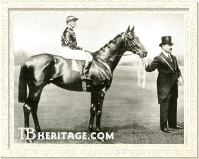
Sunstar
|
|
The colt that led Sundridge to his sire title in 1911 was SUNSTAR (dkb/br.c. 1908 out of Doris by Loved One). Bred and raced by Jack Joel, he was from Sundridge's second crop. A good but not great colt at two, Sunstar won the Exeter Stakes (Newmarket), International TYO Plate (Kempton) and dead-heated for first at Newmarket with the good American colt Borrow in the Hopeful Stakes. |
At three, Sunstar's course was shifted to the classics, and he won the 2,000 Guineas beating Stedfast, and the Newmarket Stakes (ten furlongs) prepping for the Derby. In the interim, the colt pulled a suspensory working on hard ground and his trainer, Charles Morton, nursed the star into the Derby, keeping the injury top secret since he was now the favorite for the big classic. Sunstar did exactly as his trainer expected, beating Stedfast soundly, although he broke down short of the wire, which the trainer had also predicted. Sunstar was finished in a blaze of glory and retired to Childwick Bury Stud where he was a great success as a sire and a broodmare sire.
Sunstar was a vastly influential sire. He got classic winners Craig An Eran (2,000 Guineas; sire of April the Fifth, Admiral Drake, Mon Talisman), Sunny Jane (Oaks; dam of *Bright Knight), Zodiac (Irish Derby); as well as top class runners in Buchan (champion of his crop, Leading Sire in 1927, sire of Book Law, Shian Mor, Mr. Standfast and many top broodmares), Galloper Light (Grand Prix de Paris; sire of Oaks winners Beam and Light Brocade), *Sunbonnet (champion three-year-old filly in the U.S.), Saltash (Eclipse Stakes), Scopas (Grosser Preis von Baden), and Banstar.
Sons of Sunstar were quite successful as sires and included Leading Sire Buchan, Craig An Eran, Banstar (in France), Zambo (in France, sire of French 2,000 Guineas winner Le Becau), Alan Breck (Leading Sire in Argentina), and several who came to the U.S. led by the good two-year-old runner *North Star III (sire of Kentucky Derby winner Bubbling Over, Busy American, Terry, and the dams of Blue Larkspur, Balladier, Baba Kenny, Tiger), *Star Hawk (sire of champion and Kentucky Oaks winner Startle), *Roselyon (sire of Kings Plate winners Aymond and Willie the Kid), *Paicines, *Hand Grenade, *Porte Drapeau, *Hollister and *War Cry.
Sunstar daughters produced Ellangowan (2,000 Guineas), Kopi (Irish Derby), Concerto, Atys, Signal Light, Coup de Lyon, Guiding Star, Gay Gamp, Sunny Trace, Tetranella, Queen of the Hills, Amuse, Winsome Way, Ancient Queen, Tiffin, Council Rock, Insco, and Wayabout. His imported daughter *Sunstep was a foundation mare for Claiborne Farm and from her are descended Never Say Die (Derby), Sir Damion, Gallant Sir, and Indian Nurse.
|
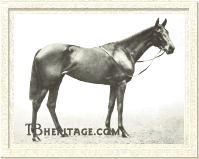
Jest
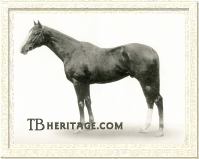
Absurd
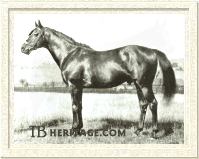
Sun Briar
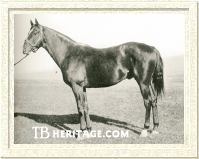
Sunreigh
|
|
Joel also bred Sunstar's classic winning daughter, JEST (ch.f. 1910 out of Absurdity by Melton), out of the Childwick Bury blue hen Absurdity, dam also of Black Jester and Absurd. At two, she won half of four starts including the Bretby Stakes. The next season, she won the 1,000 Guineas by a head over Taslett, and soundly beat Depeche by two lengths in the Oaks. A small filly, she was disappointing as a broodmare in that she produced only one winner, but that was the Derby winner Humorist (by Polymelus). She also produced Chief Ruler (by The Tetrarch), who became a leading sire in New Zealand.
Jest's year-older brother ABSURD (ch.c. 1909 out of Absurdity by Melton) was one of the top two-year-olds of 1911 when he won the Clearwell Stakes at Middle Park Stakes. Only stakes-placed at three in sprints, he was sold to stand in New Zealand, where he became the Leading Sire five times.
Marcel Boussac bred *SUN BRIAR (b.c. 1915 out of *Sweet Briar II by St. Frusquin), who was sold as a yearling, and was sent to the U.S. due to depressed racing in Europe upon the outbreak of World War I. Originally named "Sunday," he was sold as a yearling at Saratoga to W.S. Kilmer and became the next season's champion juvenile. *Sun Briar won the Hopeful, Saratoga Special, Grand Union, and Great American Stakes and Albany Handicap. At three, prepping for the Kentucky Derby, he required a workmate, and Kilmer purchased a useful gelding named Exterminator. *Sun Briar missed the main event, won in his absence by Exterminator, who went on to greater things as a perennial handicap champion. *Sun Briar did not fade into obscurity however. He continued his love affair with the Saratoga season and won that season's Travers Stakes and Delaware Handicap. The next year he was the best older horse in training.
*Sun Briar retired to Kilmer's Court Manor Stud in Virginia and was an immediate success. His best included the one-time leading money-winner, Sun Beau, as well as the champion two-year-old Pompey (in the pedigrees of Polynesian and Bold Ruler), Travers winner Sun Flag, Kentucky Oaks winner Suntica, and two-time Jockey Club Gold Cup winner Firethorn. His daughter Laughing Queen (a sister to Pompey), was the third dam of Tom Fool.
|
|
So enamored was Kilmer of his *Sun Briar, that he went to France and purchased his younger full brother *SUNREIGH along with their dam, *Sweet Briar II. *Sunreigh (1919) couldn't win, and sired only 14 foals before his early death, but one of those was Kentucky Derby winner Reigh Count, sire of Triple Crown winner Count Fleet. Count Fleet, in turn, sired Kentucky Derby winner Count Turf, as well as champions Counterpoint and One Count, and his daughters became tremendous broodmares.
|
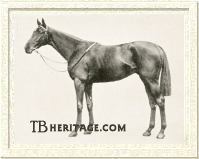
Argos
|
|
Another French-bred product by Sundridge, NICEAS (b.c. 1920 out of Nika by Ossian) was a contemporary of the brilliant *Sir Gallahad III, and although he won big races in the Grande Criterium d'Ostende, Prix de la Foret, Prix du Gros Chene, Prix de la Marettes (defeating *Sir Gallahad III), Prix Board, and Prix Edmund Blanc, he was second in the Poule d'essai de Poulains (to *Sir Gallahad III), but beat that colt again in the Prix du Jockey Club, while running second to Le Capucin, and beat him again in the Prix Jacques Le Marois. Niceas was a good but not great sire in France, getting *La Roseraie (dam of Ambrose Light, in the pedigree of Affirmed) and Dogaresse.
|
|
Sundridge's other good sons included July Cup winners GOLDEN SUN (1910) and SUNDER (1907); and Middle Park Stakes winner ARGOS (1913), sire of Diomedes.
|
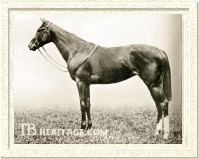
Lady Josephine
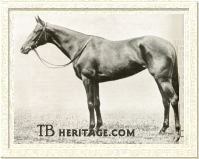
Silver Tag
|
|
One of the most influential of Sundridge's offspring proved to be, surprisingly enough, a filly, his daughter LADY JOSEPHINE (ch.f. 1912 out of Americus Girl by Americus).
Bred by A.H. Ledlie of County Cork, Ireland, she was sold at the Doncaster yearling sale to W.M. Savill for 1,700 guineas. She proved the second best filly of her year at two, winning the Coventry and Acorn Stakes.
Unplaced in her only start at three, she was offered at the Newmarket July sale and purchased, for 1,200 guineas and established herself as a broodmare at Sledmere Stud. There, she produced seven foals, four winners, led by the two brilliant race fillies, Mumtaz Mahal and Lady Juror. In 1923, Sundridge was the Leading Broodmare sire thanks in great part to the exploits of Mumtaz Mahal.
From Mumtaz Mahal (1921 f. by The Tetrarch) descended Mahmoud, Badruddin, Mirza II, Nasrullah, Royal Charger, Rivaz, Furrokh Siyar and numerous others of importance in pedigrees. From Lady Juror (1919 f. by Son-In-Law) came Fair Trial, Tudor Minstrel, Riot, Commotion and Neolight. Descendants of this female line are often possessed of the same brilliant speed and precociousness shown by Sundridge and Lady Josephine. |
Sundridge sired another top filly from the same crop as Lady Josephine in SILVER TAG (ch.f. 1912 out of Silver Fowl by Wildfowler). A stakes winner at two, three, and four, she was also placed second in the 1,000 Guineas and third in the Oaks. Other classy fillies by Sundridge included Coventry Stakes and 1,000 Guineas placed RADIANCY (1908), dam of *Vibration II; LADY BRILLIANT (1912), dam of Brilliant Jester and Black Ray; *PASQUITA (1907), dam of *Polymelian; Sun Worship, dam of Solario, Imagery and Voleuse; *Wilful Maid II, dam of Prince Pal; *Beach Talk, dam of Big Pebble; and Summer Girl, dam of *Over There and *Bathing Girl (granddam of War Admiral).
--Anne Peters
|
|
|
|

